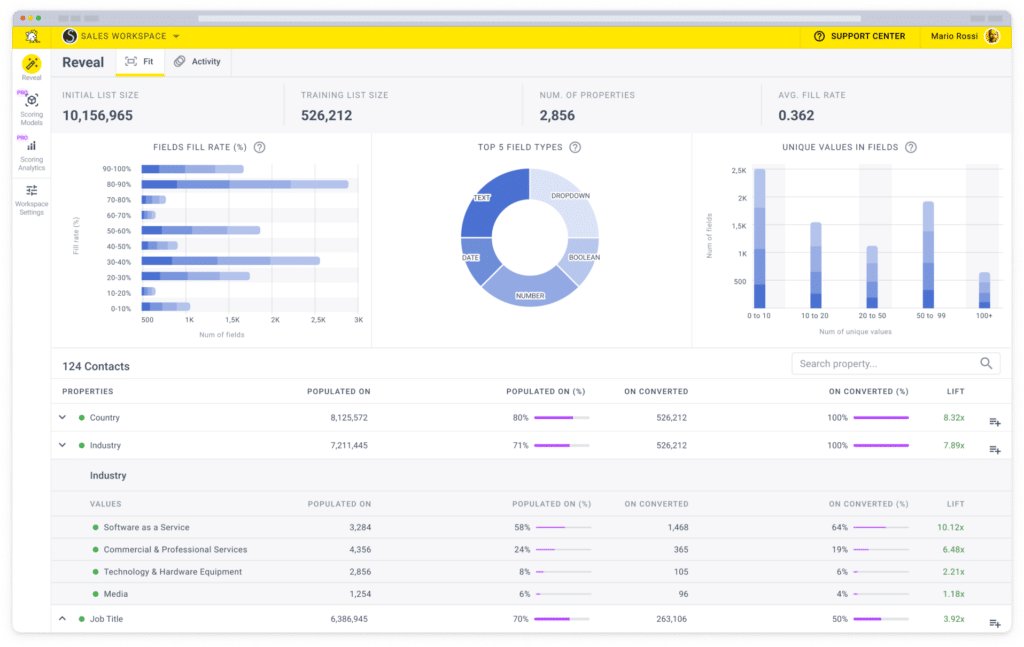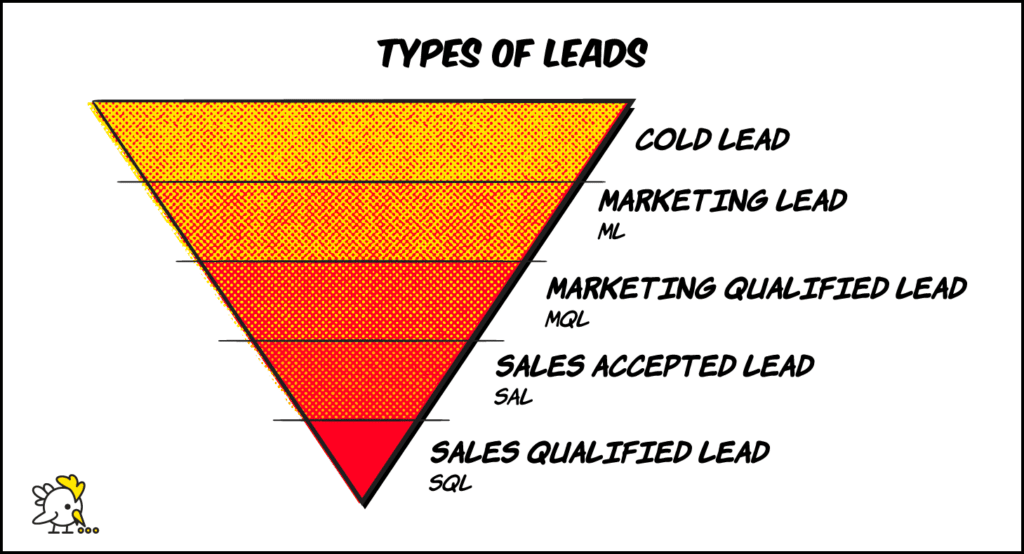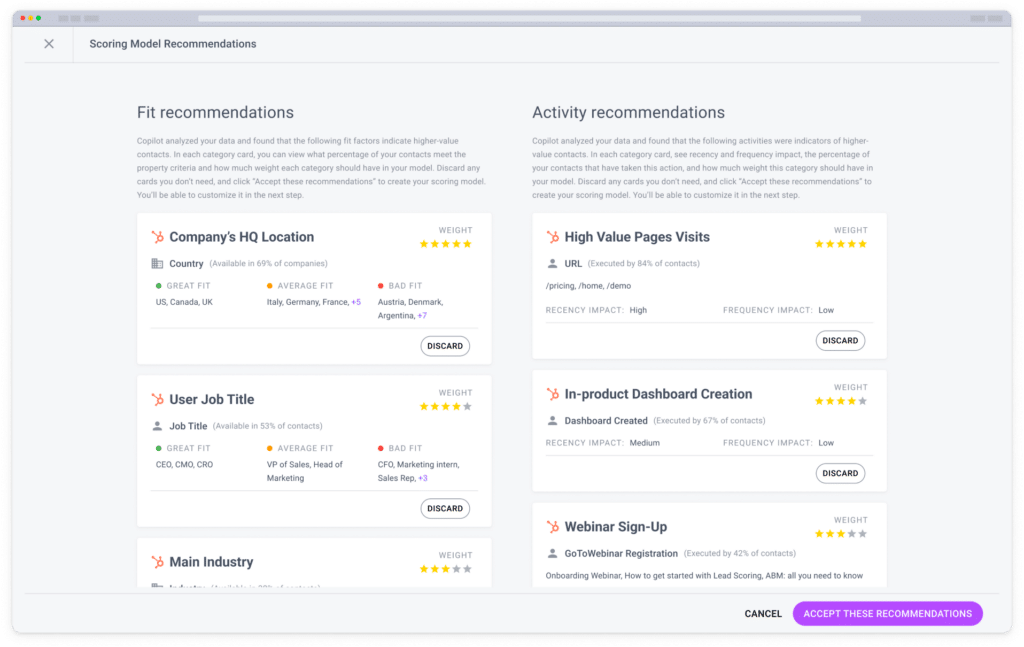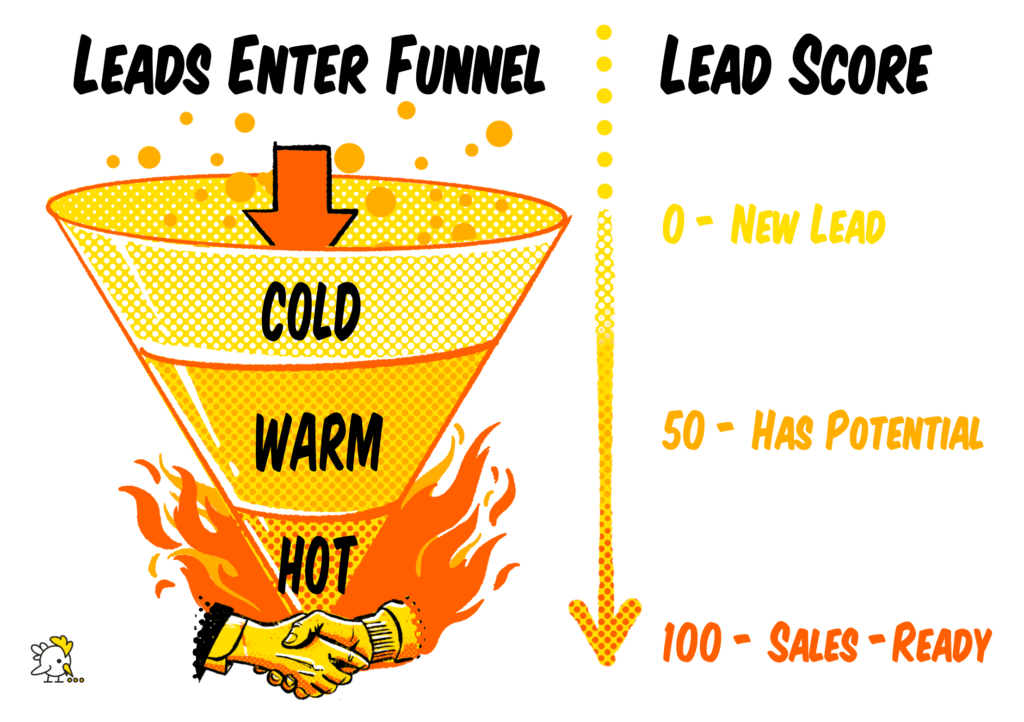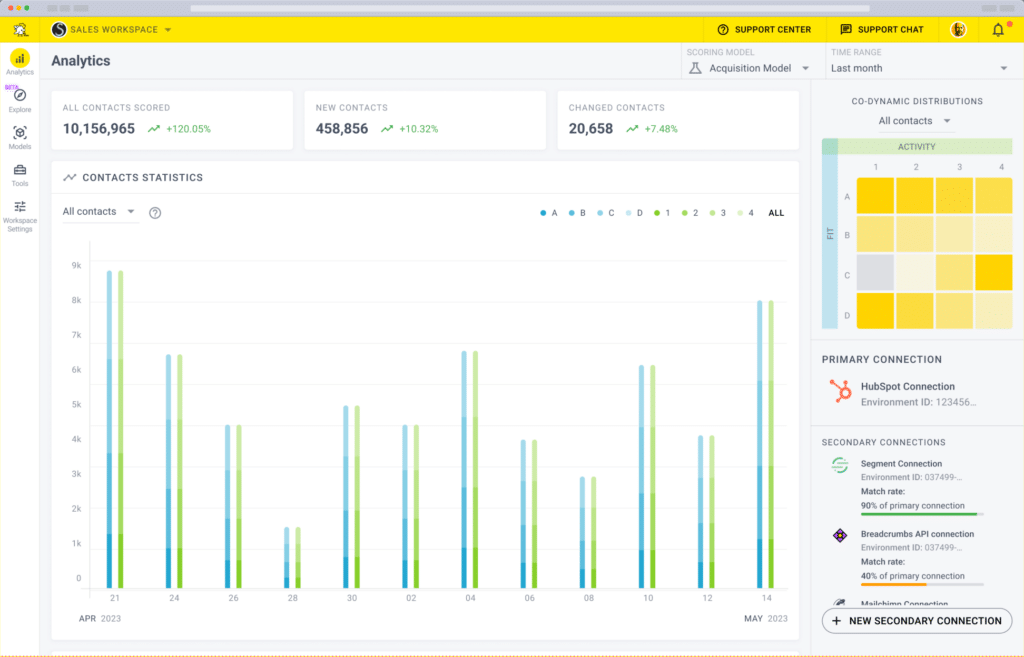B2B buyers want specialized attention, salespeople they can trust, and an easy buying process.
Aligning your sales and marketing teams is essential to meeting these requirements in an environment that shifts as rapidly as B2B SaaS sales.
Below, we’ll discuss why this alignment is so crucial, strategies you can implement to make it a reality, and how Breadcrumbs can help you capitalize on sales opportunities at critical moments with its powerful lead-scoring capabilities.
The importance of sales and marketing alignment
Imagine you’re at a baseball game, soaking up the sun and the buoyant atmosphere. Above you, you hear the welcome cry of “Hot dogs! Get your hot dogs here! Hot dogs!” You realize you’re ravenous and wave the hot dog crier over, only to discover that her box is full of popcorn.
You’re confused. Where are the hot dogs? Oh well. You like popcorn too, so you buy a bag. But this vendor seems a bit off her rocker, and you’re still hungry for a hot dog.
This example illustrates what happens when sales and marketing are out of alignment. You’re marketing hot dogs and selling popcorn. It’s confusing for the customer and a disastrous business practice for you. Yet many companies make this mistake, not realizing the harm they’re doing to their bottom line.
Benefits of sales and marketing alignment
Sales and marketing alignment are crucial to maintaining solid business operations.
Good sales and marketing alignment results in:
- Comprehensive understanding of the target audience
- Greater customer satisfaction
- Cohesive brand messaging
- Better allocated resources
- Stronger brand authority
- Increased conversions
- More qualified leads
- Higher ROI
Overall, sales and marketing alignment drives revenue growth and enhances organizational efficiency for customer satisfaction and long-term success.
9 winning strategies for aligning sales and marketing
So, how do you achieve this elusive alignment?
Here are nine winning strategies to implement.
Strategy 1: Define your ideal customer profile (ICP) and personas
Your ICP and buyer persona are going to be the guiding light for both sales and marketing.
All of the sales marketing efforts in the world won’t matter if you don’t know who you’re targeting. Both departments are targeting different pools and trying to turn leads into customers.
Breadcrumbs Reveal has a solution for this. It instantly analyzes the data-driven attributes that make up your ICP and the actions that predict a higher buying intent.
With this information, you can align your sales and marketing teams so they are focused on targets and campaigns that are most likely to convert and less focused on finger-pointing at each other.
Strategy 2: Aligning goals and KPIs to revenue
Aligning goals and KPIs to revenue provides clear accountability and measurement metrics for both sales and marketing teams.
Both sides are incentivized to collaborate throughout the customer journey, from initial lead generation to final conversion. Using a goal-tracking platform can further encourage team collaboration as you measure progress throughout the customer journey.
This alignment ensures that both departments are working towards the same end goal. This reduces silos and promotes synergy between sales and marketing activities. Just as collaboration fosters a unified approach in a professional setting, nurturing self-esteem from a young age can significantly impact an individual’s ability to work towards personal and collective goals.
Strategy 3: Regular funnel sync meetings
If you aren’t communicating, it’s incredibly easy to get out of alignment, especially in a field that shifts as rapidly as sales.
Regular funnel sync meetings enable a shared understanding of the customer journey. They also create a dedicated forum for sales and marketing teams to review and discuss the progression of leads through the sales funnel.
Crucially, they also allow for greater transparency from both departments. This frequent syncing provides a comprehensive understanding of the effectiveness of marketing campaigns and sales tactics in generating and nurturing leads.
Both departments gain valuable insights into lead behavior, preferences, and challenges. This allows them to better understand the effectiveness of their respective efforts.
Strategy 4: Using SQLs as a common metric
SQLs are leads that both sales and marketing teams have determined to have a high likelihood of converting into customers based on predefined criteria.
By establishing SQLs as a common metric, both departments are incentivized to collaborate. They work to ensure that leads are effectively identified, nurtured, and progressed through the sales funnel.
This fosters shared accountability and responsibility between sales and marketing teams since they are mutually invested in the success of the lead qualification process.
Strategy 5: Defining what success looks like for both teams
No one can reach a goal when that goal has never been defined.
As the proverbial saying goes, “If you don’t know where you’re going, any road will take you there.”
If one team is determined that success means one thing and the other team is dead set that it means something else, there’s going to be acrimony.
What success looks like for both teams should be laid out using a common language and a strategy that is easy to measure and understand.
Leave no room for doubt or confusion in defining success. As we’ve already mentioned, using regular sync meetings, aligning KPIs to revenue, and using SQLs as a common metric is a great way to do this.
Strategy 6: Aligning messaging and positioning
Remember our analogy at the beginning of this article about marketing hot dogs but selling popcorn?
How many more sales are you going to make when you sell hot dogs to people who want lunch?
Aligning the messaging and positioning of what your product is, how it works, and what problems it solves will do just that.
Sales and marketing teams should work in tandem to make sure the positioning of the brand messaging is accurate and efficient, avoiding confusion and maximizing sales opportunities.
Strategy 7: Use competitive intelligence
Competitive intelligence is the process of using openly available information on your competitors and analyzing it to find a competitive advantage.
Sales and marketing can work together here quite well.
Sales can use competitor information to design their pitches to highlight your competitors’ shortcomings and amplify your product’s strengths.
In brand messaging and ad campaigns, marketing can use competitor intelligence to respond to or engage with competitor claims.
Compiling this set of data gives sales and marketing the same pool of information to collaboratively pull from to create actionable strategies.
Tools like Unkover can help streamline this process even further by providing automated insights and recommendations based on the data you collect about your competitors.
Strategy 8: Producing quality content
According to 2024 research conducted by the Content Marketing Institute, the three most popular B2B content types include case studies and consumer stories.
Sales teams are on the frontlines of collecting this goldmine content. Sales teams have stats on who loves the product, how well it worked for them, and common questions and complaints.
9/10 B2B buyers say online content has a moderate to major effect on their purchasing decisions. So, when the marketing team is aware of the data the sales team can provide, they can create better-quality content that speaks directly to prospective customers’ needs and goals, resulting in increased engagement and revenue.
This is where B2B marketers can take a page out of the B2C playbook. Brands like StudioSuits capitalize on the market for custom men’s tweed suits by creating content that educates their audience on style and fashion.
Similarly, supply chain distributor Maadho knows its customer base cares about eco-friendly disposables and aligns its marketing and sales efforts with that messaging to maximize sales.
Don’t overlook the power of content that’s aligned with messaging and data from both departments.
Strategy 9: Use lead scoring
Lead scoring provides a standardized method for qualifying leads that both departments can agree on.
By establishing a shared framework for lead qualification, both departments can work together to define the criteria for lead scoring and adjust them as needed based on feedback and insights from the sales process.
This takes out the guesswork in the process and fosters a collaborative environment instead of combativeness.
We’ll talk more about lead scoring below, as well as how to get set up with the best lead scoring tool for aligning sales and marketing, Breadcrumbs.
Lead scoring: A key strategy for aligning sales and marketing
Lead scoring is the process of assigning a numerical value to your leads. This number is based on criteria you’ve set about how likely you think a given lead is to take a certain action.
For instance, you could assign a lead +15 points for downloading a lead magnet. This action implies a higher level of interest than, say, navigating from the home page to a blog post, which may score only +1.
Once you add up all the attributes (ranging from 1 to 100), you can determine how likely a lead is to convert. The higher the number, the higher the likelihood of conversion.
How lead scoring can help improve sales and marketing alignment
Lead scoring helps sales and marketing align because it forces them to communicate. The criteria you set for lead scoring are subjective and should be agreed upon by all invested parties.
Collaboratively agreeing on lead scoring criteria provides a common framework and language for evaluating lead quality and progression through the sales funnel.
This puts you on the same page and allows sales teams to focus their efforts on leads with the highest potential for conversion. It also makes sure that marketing efforts are directed towards generating high-quality leads that are more likely to result in sales, ultimately maximizing the return on investment for both departments.
Breadcrumbs: Enhancing lead scoring for sales and marketing alignment
If you’ve spent any time with manual lead scoring, you know that it is time-consuming and not always accurate.
Alternatively, predictive lead scoring—while helpful and time-saving—leads to being locked into narrow, inflexible models that won’t always suit your needs.
The solution is fluid and customizable models from an advanced lead scoring tool that applies machine learning to identify high-value traits in your leads.
We’d like you to meet Breadcrumbs
Breadcrumbs is an advanced predictive lead-scoring tool that offers swift automation, data-driven insights from machine learning, and adaptable flexibility from human control.
How Breadcrumbs works
Breadcrumbs uses a combination of activity scoring and firmographic data to empower you with the most accurate lead scoring possible.
Our top three criteria are:
- Recency: Recency shows how recently a lead has taken action with one of your company’s assets. This allows you to prioritize action that’s currently happening, not wasting time chasing down ancient leads.
- Frequency: Frequency is a factor many lead-scoring tools don’t take into account, but it’s crucial. Breadcrumbs tracks the frequency of actions taken and how recently they happened. The result is a pool of white-hot leads.
- On and Offline Activities: This goldmine of information will be useful to both sales and marketing teams as they align their sales efforts. Data about where and how potential customers consume information, how they buy, and what interests them allows for better targeting and segmenting of quality leads.
Demographic and firmographic information is just as important.
Firmographic data is a collection of key characteristics of businesses you’d like to target. This data can be used to create distinct marketing segments of high-value prospective customers.
Breadcrumbs leverages engagement and firmographic data to determine which leads are ready for a sales opportunity. This allows your sales team to act fast while the window is open.
Breadcrumbs’ impact on sales and marketing alignment
Breadcrumbs gives marketing and sales departments the same data points to use for measuring success.
Just as importantly, it gives them the same language to discuss the data.
When communication is streamlined this way, there’s no longer a need for finger-pointing between sales and marketing. Both departments can be more effective because every decision is data-backed and accessible to everyone.
If something isn’t working, the data will point to why. Then, the appropriate department can take action to get a fix and get back to sales targets.
See how Breadcrumbs aligns sales and marketing for businesses
Thinkific is a learning software that uses Breadcrumbs for both B2B and B2C sales processes.
Thinkific adopted Breadcrumbs to help solve two problems:
- Their sales and marketing departments weren’t aligned. They weren’t communicating well, which was causing clashes between the two departments.
- They didn’t have any data that could determine lead quality in a quantifiable way.
After integrating Breadcrumbs into their sales efforts, Thinkific saw rapid improvement on both fronts.
Their marketing department was able to create lead-scoring models they could communicate to the sales team. The sales team then integrated the lead scoring models into their sales processes, creating a synchronicity and alignment between departments.
On the data side, they doubled their MQL to OPP rate in three months and reduced their SLA by 99.9%.
After such incredible results, Thinkific’s VP of Marketing, Christie Horsman, stated, “On both sides [sales and marketing], you see a vast improvement, so I don’t understand why someone would wait on [using Breadcrumbs]. For me, it’s now an imperative tool that’s built into our tech stack, and it’s not going anywhere.”
Conclusion
Sales and marketing must work together for optimal revenue and excellent customer experiences to be possible.
Achieving this has its challenges, but with enough clear communication, a common language, and direct measures of success, it’s absolutely possible.
Incorporate powerful lead-scoring tools like Breadcrumbs into your tech stack to centralize your data, align your sales and marketing departments, and start implementing winning strategies that’ll result in replicable success for your business.
Ready to learn more? Book a demo with us today!

